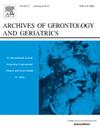Trajectories of health-related quality of life and their association with disability in older Australians
IF 3.8
3区 医学
Q2 GERIATRICS & GERONTOLOGY
引用次数: 0
Abstract
Background
The relationship between various disabilities and the trajectories of HRQoL in older populations remains largely unexplored. Therefore, we aim to investigate the connections between HRQoL trajectories and different types of disabilities in older Australians.
Methods
The study participants' HRQoL was measured using the SF-6D utility index. We applied the group-based trajectory model to identify distinct HRQoL trajectories and employed multinomial logistic regression to examine the relationship between HRQoL trajectories and various types of disabilities.
Results
We identified three distinct trajectories of HRQoL among older Australians: low-declining, moderate-declining, and high-stable HRQoL groups. We found evidence indicating that the relative risks of being in the low-declining HRQoL group are greater for all types of disabilities. Older Australians living with physical disabilities (Relative Risk Ratio [RRR]: 6.62, 95 % CI: 4.76–9.22), psychosocial disabilities (RRR: 14.06, 95 % CI: 2.85–69.46), and other disabilities (RRR: 4.64, 95 % CI: 3.51–6.12) face a higher relative risk of being in the low-declining HRQoL group compared to their counterparts. Similarly, older Australians with work-limiting disabilities (RRR: 15.96, 95 % CI: 11.99- 21.24), disability onset (RRR: 10.61, 95 % CI: 8.19- 13.75), and multiple disabilities (RRR: 19.12, 95 % CI: 13.96- 26.18) also have a higher relative risk of being in a low-declining HRQoL group compared to their counterparts. Conclusions: Our findings emphasise the urgent need for targeted interventions and support services for older Australians with physical, psychosocial, and work-limiting disabilities to address their elevated risk of declining HRQoL and enhance their overall well-being.
澳大利亚老年人与健康有关的生活质量轨迹及其与残疾的关系
在老年人群中,各种残疾与HRQoL轨迹之间的关系在很大程度上仍未被探索。因此,我们旨在研究澳大利亚老年人HRQoL轨迹与不同类型残疾之间的联系。方法采用SF-6D效用指数测定研究对象的HRQoL。我们采用基于群体的轨迹模型来识别不同的HRQoL轨迹,并采用多项逻辑回归来研究HRQoL轨迹与不同类型残疾之间的关系。结果:我们确定了澳大利亚老年人HRQoL的三种不同轨迹:低下降、中等下降和高稳定HRQoL组。我们发现有证据表明,在所有类型的残疾中,处于低下降HRQoL组的相对风险都更大。患有身体残疾(相对风险比[RRR]: 6.62, 95% CI: 4.76-9.22)、心理社会残疾(RRR: 14.06, 95% CI: 2.85-69.46)和其他残疾(RRR: 4.64, 95% CI: 3.51-6.12)的澳大利亚老年人与同龄人相比,处于HRQoL低下降组的相对风险更高。同样,与同龄人相比,具有工作限制性残疾(RRR: 15.96, 95% CI: 11.99- 21.24)、残疾发病(RRR: 10.61, 95% CI: 8.19- 13.75)和多重残疾(RRR: 19.12, 95% CI: 13.96- 26.18)的澳大利亚老年人处于低HRQoL组的相对风险也更高。结论:我们的研究结果强调,迫切需要针对身体、心理和工作限制残疾的澳大利亚老年人进行有针对性的干预和支持服务,以解决他们HRQoL下降的高风险,并提高他们的整体幸福感。
本文章由计算机程序翻译,如有差异,请以英文原文为准。
求助全文
约1分钟内获得全文
求助全文
来源期刊
CiteScore
7.30
自引率
5.00%
发文量
198
审稿时长
16 days
期刊介绍:
Archives of Gerontology and Geriatrics provides a medium for the publication of papers from the fields of experimental gerontology and clinical and social geriatrics. The principal aim of the journal is to facilitate the exchange of information between specialists in these three fields of gerontological research. Experimental papers dealing with the basic mechanisms of aging at molecular, cellular, tissue or organ levels will be published.
Clinical papers will be accepted if they provide sufficiently new information or are of fundamental importance for the knowledge of human aging. Purely descriptive clinical papers will be accepted only if the results permit further interpretation. Papers dealing with anti-aging pharmacological preparations in humans are welcome. Papers on the social aspects of geriatrics will be accepted if they are of general interest regarding the epidemiology of aging and the efficiency and working methods of the social organizations for the health care of the elderly.

 求助内容:
求助内容: 应助结果提醒方式:
应助结果提醒方式:


